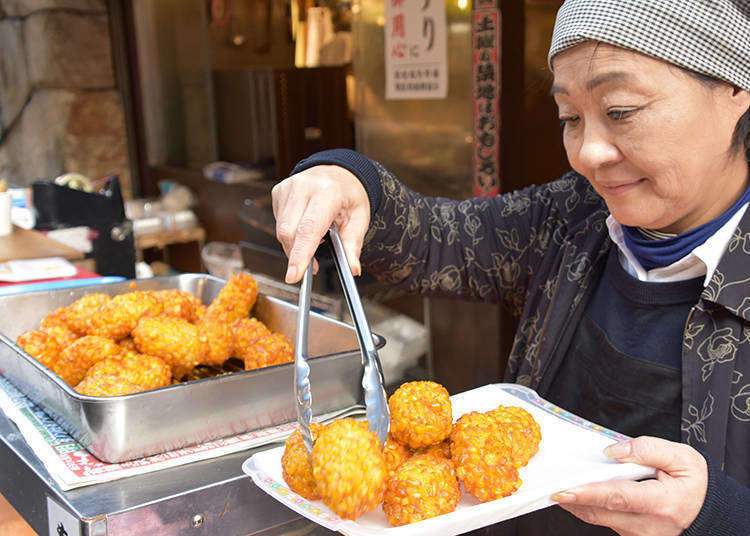
Japanese Street Food is Just Like You Imagine - And Here's One of The Best Places to Experience it (Tsukiji)
- Written by: Nina Cataldo
Formerly home to the world-famous Tsukiji Fish Market, Tsukiji is still an incredible place to explore! Tsukiji’s original narrow and lively streets filled with variety of vendors functions proudly, despite being over 80 years old. With the area's name and reputation, visitors may assume that all cuisine found here are limited to seafood, but this is where the secret is revealed. Tsukiji’s Outer Market consists of fresh fruit vendors, kitchen tools, and most exciting of all, lots of street food that is unique and limited to this market. Here are the top picks for famous Tsukiji street food, all but one not consisting of fish!
1. Tamago-yaki
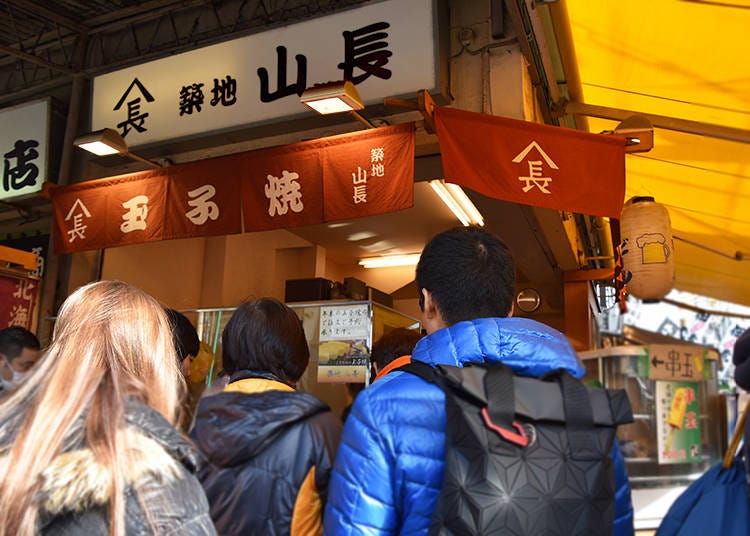
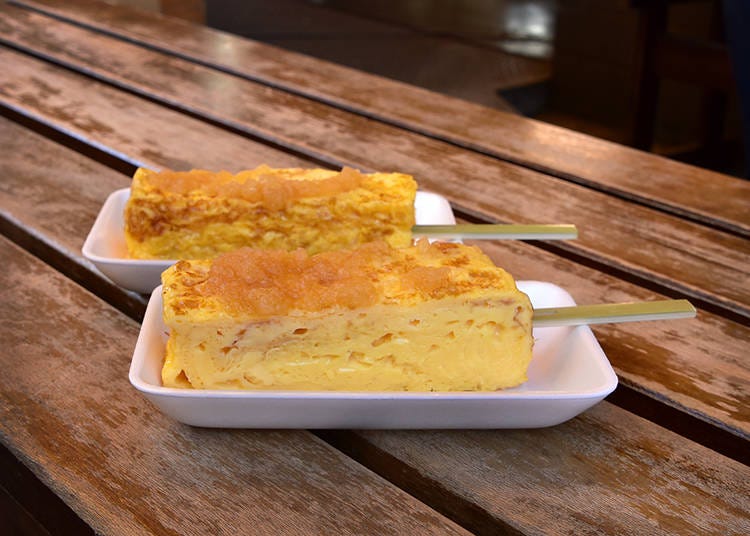
This sweet egg omelette dish called Tamago-yaki is commonly found in bentos and as sushi toppings. The ones at Yamachou (山長) come piping hot on a stick with a side of ground radish called oroshi daikon. You can choose between regular sweetness and less-sweet but to tell you the truth, both are still sweet compared to the average egg omelette.
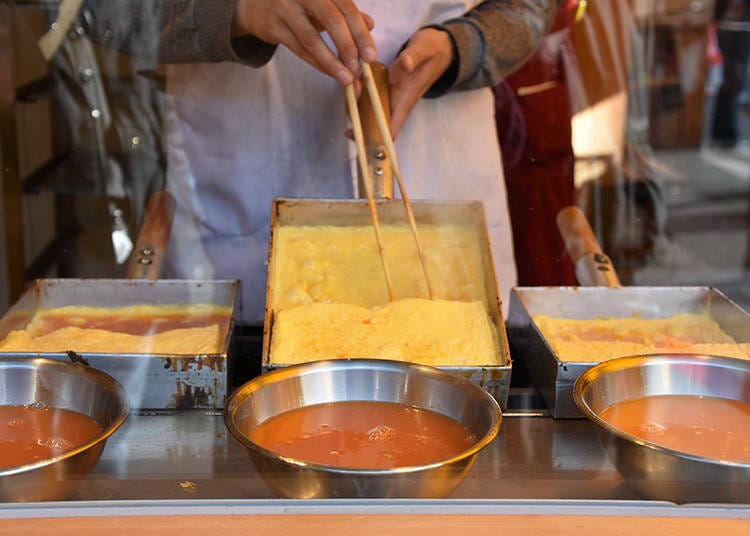
Yamachou, which stands on a wide corner of the market, has the tamago-yaki making process visible for passersby. The chef works three square pans at once, pouring in and tilting the egg yolk to create one layer after another. If you’re not keen on sweet egg, at least swing by to watch the fascinating process.
Tamago-yaki: 100 yen for one
-
Yamachou山長
- Address 4-10-10, Tsukiji, Chuo-ku, Tokyo, Japan
- Phone Number 03-3248-6002
Open hours: 6:00a.m - 3:30p.m
Closed: none
2. Shumai
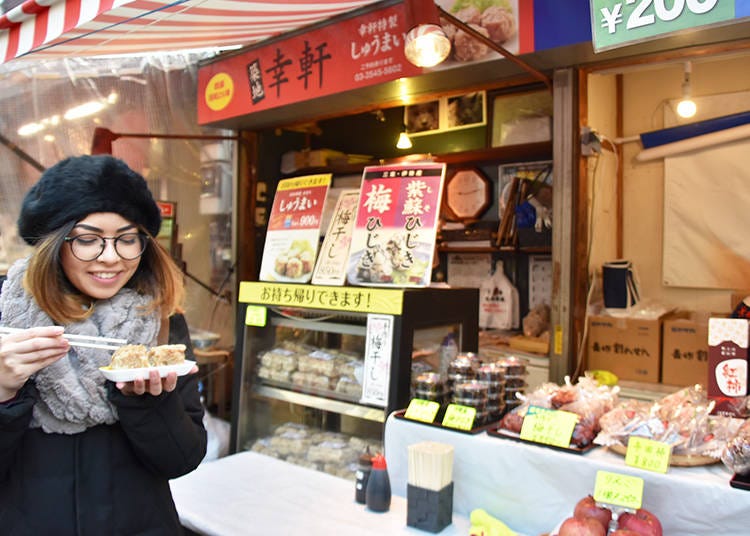
Pork dumplings aren’t hard to find in Asia. Many countries and regions have their own take on this dish with Chinese origins. I, for one, didn’t think the ones at Tsukiji would be much different than others I’ve tried, but I was completely wrong.
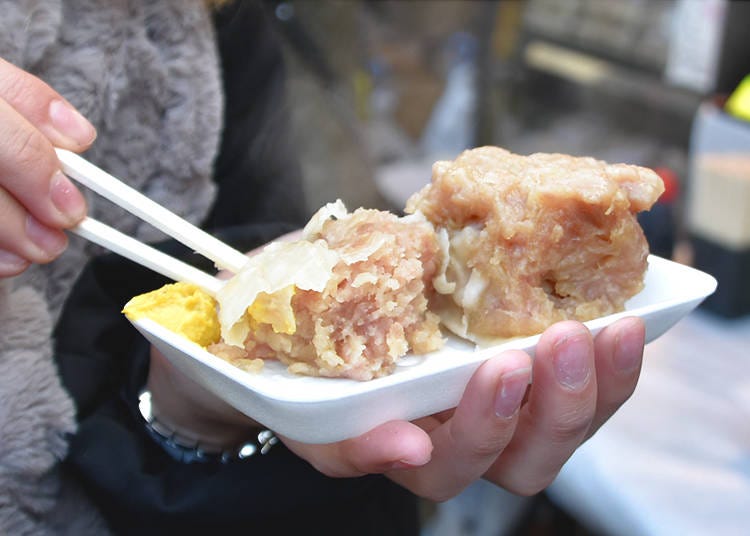
First of all, the size of one shumai at Saiwaiken (幸軒) is three times as big as ones I’ve eaten before. The outer wonton skin is not as thick and chewy as normal shumai, but instead melts right into the juicy meat. The minced meat itself is mixed with sauteed onions which brings out the natural sweet flavor of the vegetable, so much so that you’d think the shumai has some sweet additives (don’t worry, it doesn’t!). Customize each bite with different condiments from sweet sauce to Japanese mustard (karashi). Just be sure to go easy on the mustard, as it tends to carry the similar stinging sensation as wasabi. Be sure to compare all tastes - including plain, my personal favorite.
Shumai: 150 yen for one
-
Saiwaiken幸軒
- Address 4-10-8, Tsukiji, Chuo-ku, Tokyo
- Phone Number 03-3545-5602
Open hours: 5:00a.m - 1:00p.m, 10:00a.m - 2:00p.m on Sundays
Closed: none
3. Menchi-katsu and Croquette
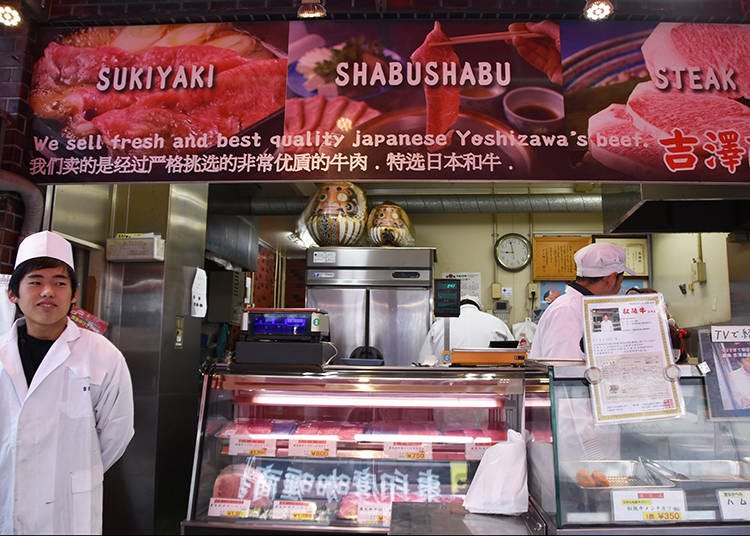
Yoshizawa-Shoten (吉澤商店) is famous for domestically grown, fresh beef. This butcher has ready-to-go plate packs of thinly sliced meat for traditional Japanese cuisine such as shabu shabu and yakiniku. However, Yoshizawa-Shoten is also famous for mouth-watering fried snacks, which were even introduced by a celebrity on a Japanese TV show. The number one seller is the House Special menchi-katsu: fried minced meat cake dipped in and fried with panko batter. Its appeal is the use of the domestic high-quality Matsuzaka beef. The taste is truly a meat-lover’s delight.

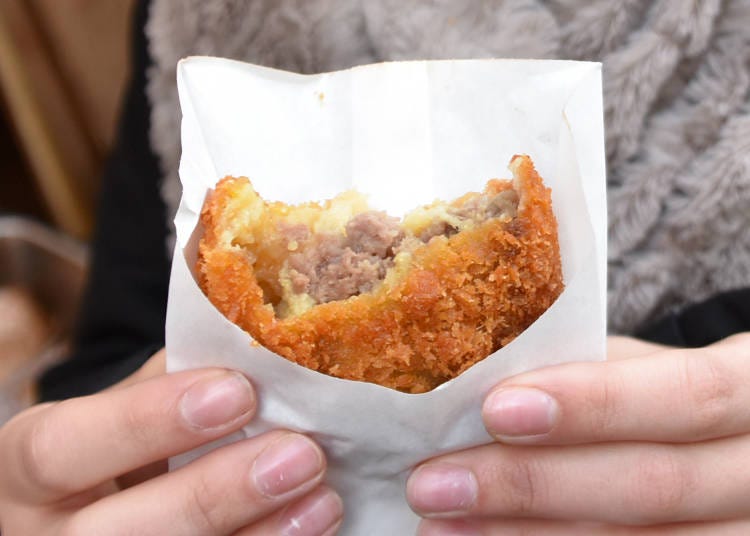
If you’re intrigued by freshly fried foods but hesitant about the overpowering taste of the menchi-katsu, I recommend the classic croquette stuffed with creamy mashed potato and mixed minced pork and beef. Yoshizawa-Shoten also takes pride in their homemade katsu-sauce (sweet brown sauce commonly used on fried foods in Japan) which goes well on all four types of their fried snacks.
House special Matsuzaka beef Menchi-katsu: 350 yen for one
Croquette: 120 yen for one
-
Yoshizawa-Shoten吉澤商店
- Address 4-13-5, Tsukiji, Chuo-ku, Tokyo
- Phone Number 03-3541-4656
Open hours: 7:00a.m - 1:30p.m
Closed: Sunday
4. Morokoshi-agé
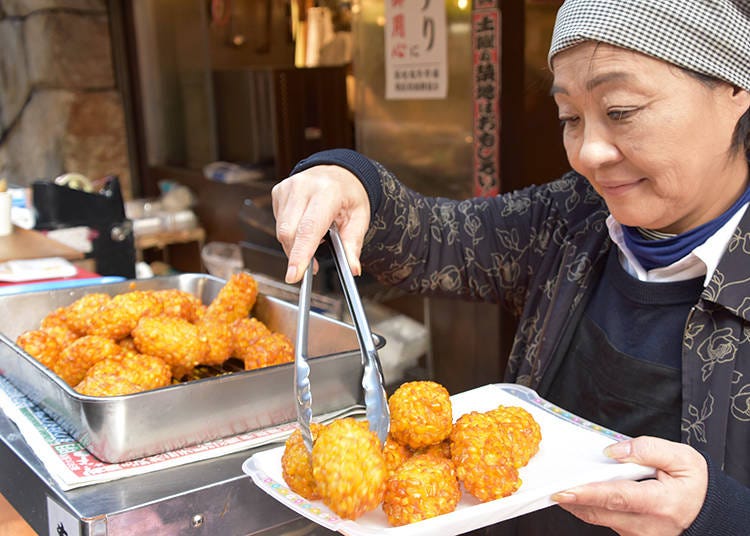
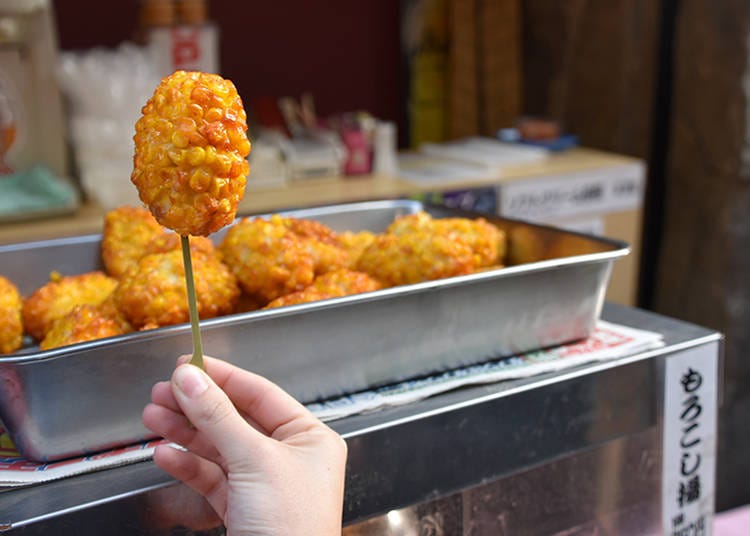
This is the only street food item on our list that consists of fish. But even with that warning, if you don’t have dietary restrictions against fish, you would never even know this dish consisted of fish! Morokoshi-agé served in Aji-no-Hamato (味の浜藤), is made from grilled sweet corn, as the name morokoshi is derived from the food name itself, tomorokoshi. The fish paste is balled into oval shapes and then rolled into the sweet corn, then lightly fried. And when I say sweet corn, I’m not kidding around here! This dish brings out the sweetest nature of the vegetable and serves as a unique punch of flavor in your day full of street food sampling.
Aji-no-Hamato also carries many other unique grilled and fried goodies, such as shiso and cheese fry up , and a seasonal tempura (Kabocha, or pumpkin for December).
Morokoshi-agé: 350 yen for one
-
Aji-no-Hamato味の浜藤
- Address 4-11-4, Tsukiji, Chuo-ku, Tokyo
- Phone Number 03-3542-2273
Open hours: 8:00a.m - 3:00p.m
Closed: none
5. Ichigo-daifuku

Speaking of sweet foods, Tsukiji’s Outer Market also offers real dessert treats, too. The fruit vendors at Tsukiji present their products as if they are colorful paintings at a gallery; color coordinated, artistically placed to catch our eyes, making all passersby intrigued by the strawberries and grapes on skewers and mountains of seasonal harvest. Among these, a strawberry vendor by the name of Soratsuki (そらつき) specializes in combining the fruit with Japan’s much-loved mochi dango. Ichigo-daifuku isn’t an invention by this vendor, but it has taken the traditional Japanese dessert and put a modern take on it.

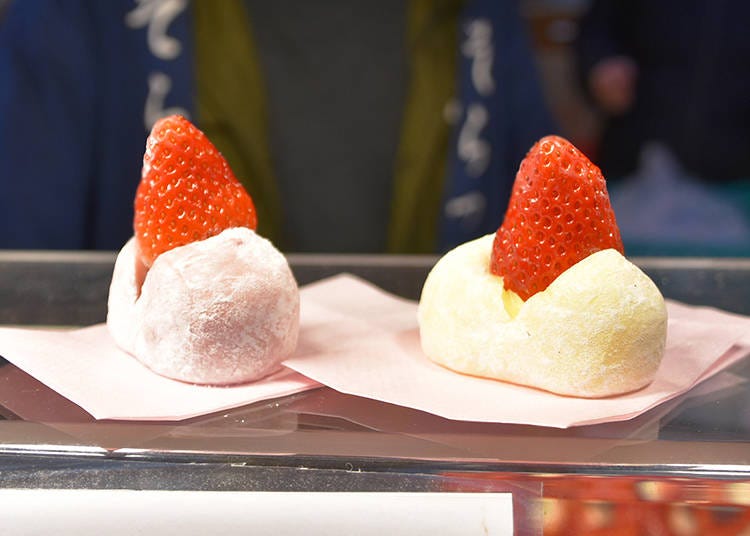
Original ichigo-daifuku consists of sweet red bean paste, anko, wrapped in gooey mochi, and topped with a strawberry (sometimes the strawberry is wrapped inside the mochi ball). While Soratsuki has this delicious original flavor, as I got to try, there are a handful of ichigo-daifuku with unique fillings to try as well. The custard cream was my personal favorite because of the perfect melodic mix of creamy handmade custard and mochi. Some other filing flavors include chocolate, matcha, and strawberry yogurt so find your favorites!
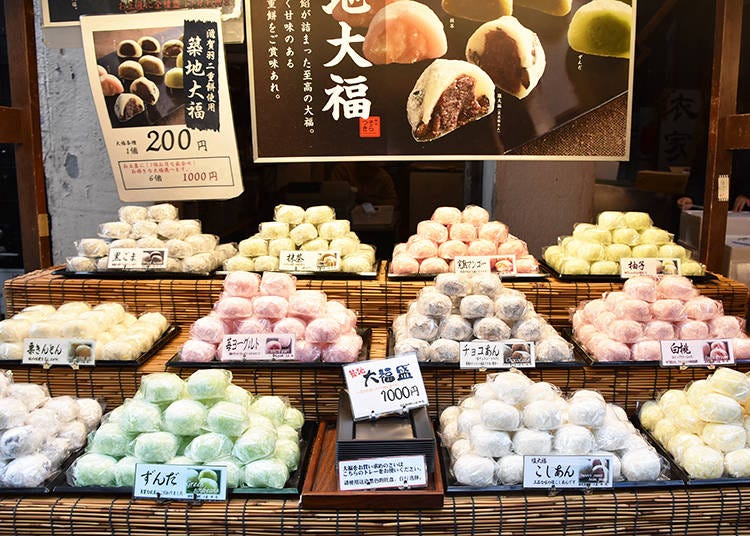
The vendor also carries simple daifuku sans large strawberry topping. These are pre-wrapped and make perfect snacks to save for later or to make as gifts (please pay close attention to the expiry date). The simple daifuku have flavors additional filling flavors, such as peach, mango, and yuzu (Japanese citrus).
Ichigo-daifuku: 300 yen for one
Daifuku: 200 yen for one
-
Soratsukiそらつき
- Address 4-11-10, Tsukiji, Chuo-ku, Tokyo
- Phone Number 03-6264-1763
Open hours: 8:00a.m - 3:00p.m
Closed: none
6. Maguro-yaki: Fish-Shaped Cake
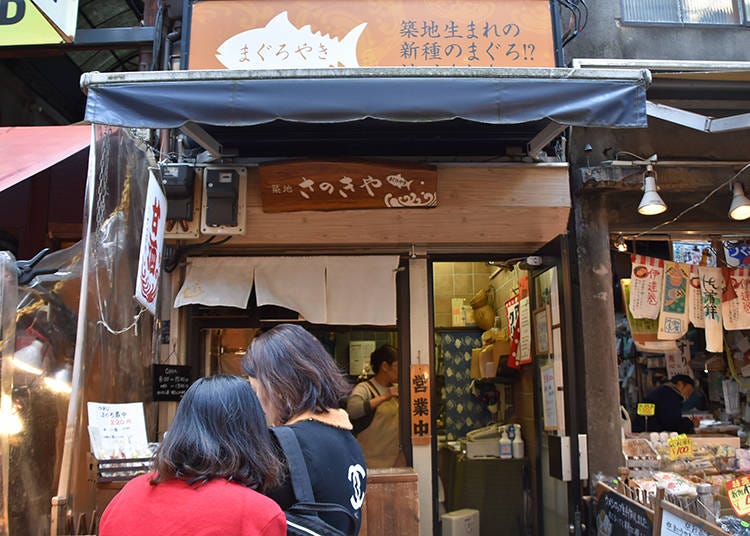
Maguro-yaki is a Tsukiji twist on another long-established Japanese sweet snack. It’s made just like taiyaki, a fish-shaped cake with red bean paste or custard filling. Instead of sea bream shaped mold, the pancake-like batter is cooked in tuna shaped molds, thus the name maguro-yaki. Tuna is the symbol of Tsukiji because of the market’s formerly famous tuna auction.
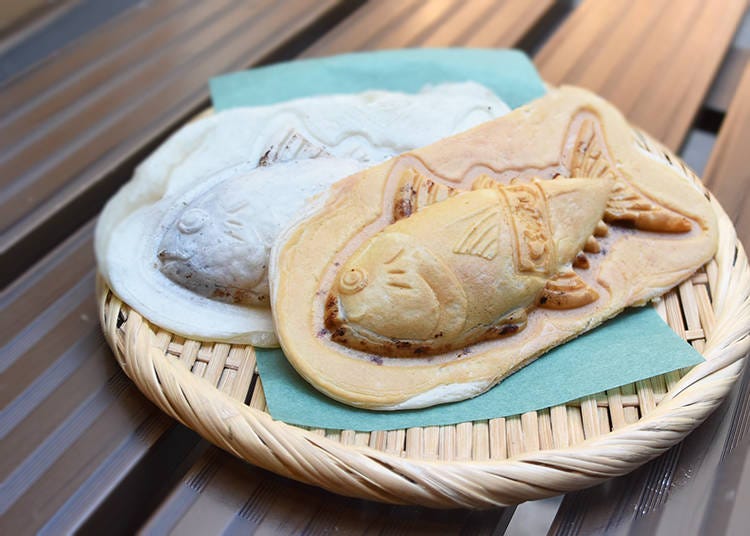
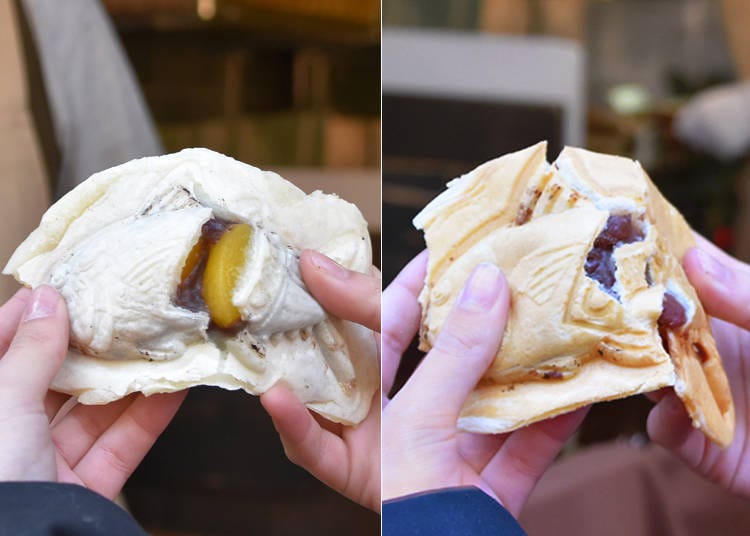
At Sanokiya (さのきや), the snack comes in two types of texture; crunchier outer layer with red bean paste filling, or a gooey, mochi-like texture for the outer layer with red bean paste and apricot inside. The second, softer type is called chu-toro at Sanokiya, which is somewhat of a wordplay since chu-toro usually refers to fatty tuna sushi. The filling is not as hefty as some taiyaki joints, and at the same time, the batter layer is not too fluffy and thick like cake.
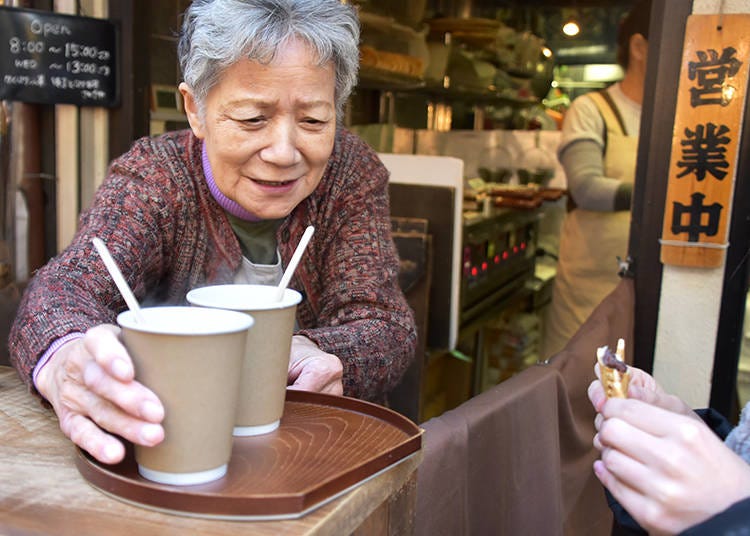
The batter-to-filling and texture ratios are the secret key to making the original maguro-yaki, and there’s no one better to make them than the veteran power ladies of the small joint. Sanokiya also served warm and cold drinks, including homemade hot amazake, a hit craze right now for its health benefits. Contrary to its name, it’s nonalcoholic, and it pairs well with the maguro-yaki! Enjoy the snacks and drinks while sitting on the tiny benches by the vendor.
Maguro-yaki
Hon-Maguro (normal type): 200 yen for one
Chu-toro: 220 yen for one
Amazake: 300 yen
-
Sanokiyaさのきや
- Address 4-11-9, Tsukiji, Chuo-ku, Tokyo
- Phone Number 03-3543-3331
Open hours: 7:00a.m - 3:00p.m
Closed: Sunday
Street Food Etiquette in Japan
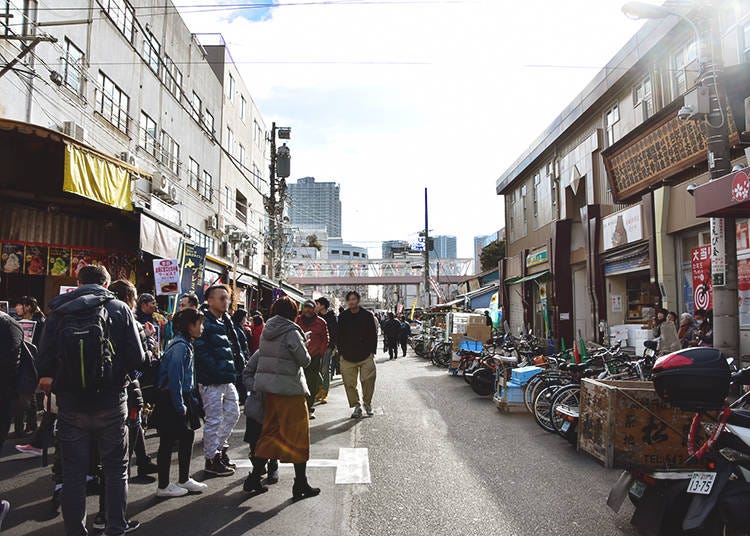
The Japanese culture typically frowns upons eating while standing or walking in public, but street food vendors are still common at matsuris and markets like Tsukiji. The proper etiquette is to eat the food at the designated area by the specific food vendor. Many stalls have tables with napkins and condiments you can stand around, benches, or a marked areas where the vendors will ask customers to stay in to eat their food. This is to make surrounding vendors are respected and to keep the streets clean.
Useful Tips For When You Visit Tsukiji

1. Go early: Tsukiji gets crowded with tour groups by 10AM. For the best and relaxing experience, go early to ensure that food isn’t sold out or the shop isn’t already closed.
2. Everything closes early: Another reason to go early in the morning (between 6AM and 10AM) is because many sushi restaurants and food stalls close by early afternoon. It’s an early-morning world. If you head out by the time you’re hungry for lunch, it might be too late!
3. Check the calendar: The market is closed on certain days, so be sure to check its holidays before heading there.
4. Relocation: The main part of Tsukiji Fish Market will officially move to its Toyosu location in Fall of 2018. However, the Outer Market showcased in this article will remain in the Tsukiji location.
Nina is a globe trotter and storyteller, constantly seeking adventures in her motherland of Japan. She's a collector of travel brochures, a lover of cats, and a half-daring foodie. She also likes to escape Tokyo city life from time to time to discover new trails in rural Japan, where she enjoys connecting with locals and wanderers alike. By profession, Nina is the co-author and editor of DUO Elements, a conversational English book series.
- Area
- Category
*Prices and options mentioned are subject to change.
*Unless stated otherwise, all prices include tax.
Recommended places for you
-

Koube Beef Kappo OMOKI Shinnihonbashi
Other Japanese Food
Tokyo Station
-

MomotaroUeno
Other Japanese Food
Ueno
-

GINZABANSUKESHINJUKUTAKASHIMAYATAIMUZUSUKUEA
Other Japanese Food
Shinjuku
-

wagyuutokome Nakatake
Other Japanese Food
Ginza
-

Naritasan Shinshoji Temple
Temples
Narita
-

Wasui Yaesuten
Other Japanese Food
Tokyo Station
-

Spring Flowers and Colorful Events Around Tokyo in 2025 – Perfect for Your April and May Itinerary
-

Best Things to Do and See in Tokyo in May 2025: Area Events and Festivals
by: Kaori Kimura
-
Ad

Tokyo Comedy Bar: Where Jokes and Craft Beer Flow Freely
-

Japan's Top Tourist Pitfalls—And How to Outsmart Them, According to a Tour Conductor
by: Miyu Shimada
-

Where to Stay in Matsumoto: 15 Excellent Accommodations Near the Alps, Castle & Onsens
by: Himanshi Shah
-

Can Art Explain Godzilla? Tokyo's New Exhibit Takes a Shot
Inspiration for Accommodations
-

Enjoy Mt. Fuji from the Comfort of Your Room! Recommended Ryokan with Mt. Fuji View
-

Stay Near the Cherry Blossoms! Hotels for Cherry Blossom Viewing in Tokyo
-

Family-Friendly Hotels with Free Shuttle to Disneyland: Convenient Access for a Magical Stay
-

Top Ranked Hakone Hotels with Mt. Fuji View: Enjoy Stunning Scenery from Your Private Space
-

Convenient Tokyo Hotels with Airport Shuttle: Ideal for Families and Heavy Luggage
-

Stunning Tokyo Tower View Hotels: Enjoy Spectacular Scenery from Your Private Space
-

Convenient Asakusa Hotels with Kitchens: Ideal for Extended Family Visits
-

Experience Luxury: Hakone's 10 Best Five-Star Accommodations
-

Enjoy Mt. Fuji Autumn Leaves! Top Hotels Near the Popular Autumn Leaves Corridor
-

Experience Hakone Fall Foliage from Your Room with Stunning Views
-

Matcha: Snacks and Sweets
-

Tokyo Tsukiji|Tsukiji Area Map & Sightseeing Information
-

Easy Day Trip from Tokyo! Ultimate Sightseeing Guide for Hakone & Lake Ashinoko!
-

Top 7 Popular Japanese Mushrooms That Are Both Tasty and Healthy
-

Tokyo Dining: Pork Cutlets, Beef Cutlets - 3 Places to Enjoy 'Tonkatsu' and 'Gyukatsu' in Shibuya!
-

What is Matcha? Behind Japan's Traditional Tea
- #best ramen tokyo
- #what to buy in ameyoko
- #what to bring to japan
- #new years in tokyo
- #best izakaya shinjuku
- #things to do tokyo
- #japanese nail trends
- #what to do in odaiba
- #onsen tattoo friendly tokyo
- #daiso
- #best sushi ginza
- #japanese convenience store snacks
- #best yakiniku shibuya
- #japanese fashion culture
- #best japanese soft drinks















